Audi S4, S5 use quattro to blow by winter
By John Gilbert
Twice this winter, my driveway has been graced by three new cars for appraisal during specific weeks, and on both of those weeks my Great White North region of Minnesota became truly white with traffic-clogging blizzards on the North Shore of Lake Superior. On both of those weeks, Audi models have been the reluctant stars.
First, I had two impressive new sedans, plus an Audi S4 quattro S-tronic sedan. Now, Audi makes a very fine A4 sedan, the company’s bread and butter vehicle that bridges the gap from compact to midsize. It drives well, handles well, and gets good fuel economy. Audi also makes an “S” model of the A4, called the S4, which gets all sorts of high-performance upgrades — engine, transmission, suspension, brakes, interior, exterior, virtually everything.
Why, I thought, did they send me a sporty sedan built for high-performance in the middle of winter? For the first three days of the week, I hopped back and forth between the other two, both new front-wheel-drive sedans. And then we got hit with an 8-inch blizzard. The two front-wheel drivers were OK, but they did spend an inordinate amount of their drive time spinning for traction and chattering the traction-control indicator instead of filling me with confidence that we were going to go straight up that hill.
So I ambled over to the snow-covered S4. Knowing it has quattro, which is a traditional all-wheel drive system that Audi created, improved, and has pretty well perfected by now. Audi, by the way, insists that “quattro” be spelled with a lower-case “q” — which I insert here just so readers of car magazines who see quattro always capitalized will appreciate how arrogance can supersede proper spelling. At any rate, I knew the quattro system would scratch and claw, even though the S4 comes with low-profile, high-performance handling tires. When I looked, however, those neat Audi wheels were shod with Bridgestone Blilzzak low-profile winter tires.
For the rest of the week, I left the two all-new FWD sedans parked and cavorted over, through, uphill and around snowdrifts, plowed piles, and icy streets in the Audi S4 quattro. Blizzaks are among the very best winter tires available, because they grip the ground, even on ice, and enhance your ability to get through the worst storms without any of those white-knuckle moments where you’re not sure you’re going to have traction the next time the tires go around. The original Blizzaks did a great job on ice, but decomposed quickly when you drove on normal wet or dry pavement. It was important to take them off and mount summer tires and save the Blizzaks for the next winter. Read more
Chicago Auto Show provides futuristic review
By John Gilbert
CHICAGO, ILL. — The Chicago Auto Show prides itself on being the biggest of the four major U.S. auto shows, claiming that by the time the 105th show ends its 10-day run on February 17, more people will have filed into McCormick Place than will attend the November show in Los Angeles, January’s Detroit event, or April’s New York show.
The shows each take on their own personalities. In L.A., the emphasis is on downsizing, fuel efficiency, and alternative forms of fuel; in Detroit, it’s time for the domestic Big Three to beat there chests and proclaim that they’re back to prominence, and that it’s safe to once again boast about more power and size. Chicago is more like New York, where visiting the city is part of the allure. You can’t get swallowed up as easily in Chicago, but it is loaded with fine restaurants and blues nightclubs, which makes after-hours gatherings an easy way to fill in the blanks if there is a shortage of new introductions.
This year, a lot of introductions were made at Los Angeles, and the Detroit show was dominated by General Motors, with the Cadillac ATS winning North American Car of the Year, and Chrysler LLC, with the Ram 1500 winning North American Truck of the Year, and the newly unveiled Chevrolet Corvette taking home “Car of the Show” honors from the hometown observers.
Only a few interesting new introductions at Chicago left room for the Upper Midwest attendees to examine the numerous technical advances currently going on in the industry. A highlight of the show was the public introduction of the new Mercedes Style Coupe, a stunning compact sedan that was unveiled to the media in Detroit but looked glorious on its pedestal at the Chicago show.
Some who hadn’t seen it thought it looked like a large sedan, but while it resembles the “four-door coupe” look of the previous CLS Mercedes, this one will compete as a compact, a luxury vehicle that could change the competitive balance. The car was unveiled in a major Super Bowl advertisement, where a customer was willing to make a deal with the devil for such a beautiful car, but backs out when he finds he can buy it for under $30,000 — without selling his soul.
Nissan surprised many by turning its Nismo high-performance arm on not only the 370 Z sports car, but also on a Juke. The Nismo Juke is aimed at bringing down the high cost of high performance, while fitting the subcompact runabout with a 1.6-liter turbocharged 4-cylinder upgraded to 197 horsepower and 184 foot-pounds of torque, churning through all-wheel drive. In previous efforts, Nismo has built no-compromise hot performers, with the engines, transmissions, suspensions, exterior styling and even the seats and interiors given special treatment. For the Nismo gang, the Juke is a departure.
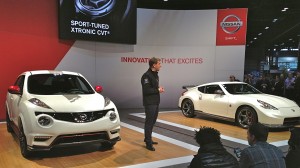
Nissan's high-performance Nismo arm unveiled a new Juke, left, and 370Z with upgraded power, performance and features. -- Photo by Jack Gilbert.
“The Juke is a polarizing vehicle, with a lot of innovations,” said Michael Bunce, chief product planner for Nissan’s large sedans and mid to compact SUVs. “Nobody is sure whether the Juke is a crossover or a car, but it doesn’t matter. We took a lot from the Nismo heritage. For example, the spoiler on the rear of the Juke Nismo really works to create 37 percent more downforce. We will offer some new features, such as a navigation system, with rear-view camera, and a Rockford-Fosgate audio upgrade. We aren’t saying the prices yet, but it will be comparable to the top-of-the-line SL grade.”
Chevrolet introduced a 2.0-liter diesel version of the compact Cruze, which will be a first for a U.S. company, and it announced intentions to go after Volkswagen’s popular Jetta, Golf and Beetle TDI models, which are currently the only compact vehicles with diesel power available.
Not to be outdone, Volkswagen showed off old-looking but new Beetle models, with the significance of a new engine lost on many observers. Ranier Michel, VW chief engineer, said, “The new Beetle GSR will have a 2.0-liter Turbo that is actually a new generation that will replace the 2.0 Turbo we’ve used for so long. It has 10 more horsepower, and it will go into the regular Golf Turbo, GTI and Jetta GLI.
Dodge Trucks, as they were formerly known, are now to be called “Ram” without the Dodge name, in an attempt to isolate the trucks into a separate brand. In Chicago, Ram unveiled its new ProMaster van — a tall, spacious commercial van that looks a lot like Nissan’s rival, and has a similarity to the Sprinter that Dodge used from Mercedes when Chrysler Corporation used to belong to Mercedes. The ProMaster comes from Fiat, the new owner of Chrysler LLC., and it has a chance to be enormously successful, Dodge officials say, because it already is very successful in Europe.
“It’s the top-selling commercial van in Europe,” said Brad Pugh, Ram’s lead engineer. “It outsells the Sprinter and the Ford Transit in Europe. When I got the chance to drive one with our Pentastar engine in it, it felt like a rocketship. All of our other vans have been pickup based, but this one has its own platform, with all four corners having active suspension. It is extremely comfortable, and it handles really well.”
The Pentastar V6 engine is a 3.6-liter dual-overhead-cam gem with variable valve timing. It replaces seven V6 engines that all were forms of stopgap designs to improve on existing engines. In all Chrysler and Dodge sedans, plus the Dodge Caravan, Jeep Grand Cherokee and now Wrangler, the engine has been very impressive, both for performance and fuel economy. Putting it into the full-size Ram 1500 pickup, with the new 8-speed transmission, was the key to SX version of the Forte, which is an eye-catching hatchback model. Hyundai’s Elantra won 2011 North American Car of the Year, then brought out an impressive companion GT 5-door hatchback on a longer wheelbase. Since the Forte rides on the Elantra chassis, the elongated and stylish Forte SX should make a similar 1-2 punch for Kia.
Many of the Asian carmakers showed off concept vehicles, which may predict uipcoming models, particularly those from Honda and Kia.
Mazda was comparatively quiet, having already shown the new Mazda6 sedan and already is shipping them to showrooms with its makeover Skyactiv design, power and transmissions. Mazda spokesman Jeremy Barnes said the new car will use a larger 2.5-liter Skyactiv 4-cylinder, and also will be coming with a 2.2-liter turbo-diesel. The diesel will become the first Japanese sedan powered by a turbo diesel, and it will be available the second half of 2013.
Barnes said the new CX-5 crossover utility is selling very well as the first all-out Skyactiv, and it, too will get thge 2.2 diesel to join the standard 2.0 gas engine. “The new 2.5 has 29 more horsepower than the 2.0,” Barnes said. “But in our test drives, we’re still seeing 32 miles per gallon with the larger engine and all-wheel drive. Like the CX-5, the Mazda6 will get Mazda’s new pair of transmissions; the company built its own 6-speed units both manual and automatic, with the automatic offering the advantages of a CVT, a direct-sequential, and a conventional automatic, but without any of the of the shortcomings each of those have.
Forte, Sorento bolster Kia armada for 2014
By John Gilbert
SCOTTSDALE, ARIZ. — Introducing two vehicles at the same time is a sketchy proposition for an auto manufacturer, because neither can attain full emphasis. But Kia is in a hurry, and with seven specific launches in the coming year, there is no choice but to package them together — which is why the 2014 Sorento SUV and Forte compact sedan both were presented together for introductory tests in the hills and desert of Arizona.
When I got my turn to drive the new Sorento and Forte, I was accompanied by Steven Hirashiki, a Kia product strategy fellow, instead of another auto journalist. That was good for a variety of reasons: I had to go directly from our lunch stop to the Phoenix airport for my return flight to Minnesota, he was able to answer some of my questions, I was able to respond to his questions about what I liked and didn’t like, and, mainly, I got to drive the whole day instead of trading turns behind the wheels.
In both cases, the vehicles performed well in assorted runs on highwayts, up0 and down hills, around curves, and in city traffic. While longer drives in both vehicles will be upcoming, my brief drives were properly impressive.
The Sorento has become one of the more successful and impressive SUVs for a changing marketplace, doing the work of large SUVs but with the agility and fuel efficiency of more compact models. And the new model improves on that already-impressive model in every way. The 3.3 engine upgrade is now truly upgraded because it has gas-direct-injection, a technique that improves both power and fuel-efficiency. Its appearance has been tweaked a bit, and the interior is easy to like. I found the performance good, although a couple of times it had a prominent jerk on acceleration at low speeds — s0mething that could improve as more miles accumulate. The steering was improved considerably, and so was the cornering stability.
The Forte never caught on in a big way when introduced in 2009, possibly due to the overwhelming response to the larger Optima and to the smaller Rio, plus the squarish Soul — which benefits by Kia’s reluctant but ultimate acceptance that the big hamsters are a lovable and popular trademark. The new Forte upgrades its design features, and its more-dashing exterior is matched by the interior Plus, the steering has a much better feel, as does the steering wheel itself, and the cornering is more precise and better reacting, as is the power in the optional 2.0-liter engine. Read more
Key still the key, in new Cadillac XTS
By John Gilbert
My son, Jack, and I had to take a little trip, and since I had two test-drive cars at my disposal at the time, I chose the one that would get better fuel economy. That meant we were going to leave behind a Cadillac XTS Platinum Collection sedan.
Now, most people might figure that was a bad move, because the XTS is the new full-size car from Cadillac, coming out as a 2013 model in a year that is big — and about to get bigger — for Cadillac, with the new compact ATS on the verge of winning the North American Car of the Year award in a few weeks. And who could mind being pampered in all that super-luxury of the XTS?
In General Motors version of downsizing, the XTS replaces the STS and all Caddies larger than that, including the DeVille, topping the new stable that is led by the CTS, with the new ATS eagerly joining on the bottom end.
Nevertheless, equipped with GM’s corporate 3.6-liter V6, with 304 horsepower and264 foot-pounds of torque, the front-wheel-drive XTS can be figured to get mid-20s fuel economy at best, and with the all-wheel-drive option, probably less. So we left it behind, in all its plushness, and drove away. I left word for my wife, Joan, who drives everything that comes into the driveway of the Gilbert Compound, that she should drive the XTS as much as possible and let me know her impressions when we returned.
Among its many features, the XTS has keyless entry, and, of course, push-button ignition. I have expressed my opinions frequently about push-button ignitions, as a solution for which there is no problem. I like the idea of being able to unlock your doors with a touch of the key-fob, but once inside the car, it seems to me that since you need the key to be with you in order to activate the push-button start, then you might as well use the key in the ignition. Besides, when you don’t need the key, it’s easy to let someone accompany you to a destination and turn over the driving responsibilities while you go your merry way with the key still safely in your pocket. But I digress. Actually, though, it is not a digression.
So there we were, driving across Wisconsin, when my cell phone rang. It was Joan. We’ve got a problem, she started, with one of those veteran-marital “we” collectives that meant she had a problem, but was more than eager to share it.
Because of the keyless ignition, and her concerns about leaving the key someplace, she set it in the cup-holder of the XTS and prepared to drive into town. Joan is pretty active, and she often goes for brisk walks along the North Shore of Lake Superior. She thought she’d probably take a walk on her way back, so she went back to the house to get her walking shoes. When she returned to the car, she thought she’d put her shoes and her jacket, in the trunk. Good move. She slammed the trunklid down, and it closed with a nice, classy “thunk.” Bad move.
As she heard the trunk close securely, she walked around to the driver’s door — and found it was locked. So were all the other doors.
Incredibly, she realized, closing the trunklid automatically and electronically locked all four doors. And the trunk. She was locked out, and the keys were safely inside, in the cup-holder. That’s when she called me. For a few miles, we wracked our brains, but could come up with no solutions. Then I thought of OnStar — GM’s exclusive customer-nanny that could direct you anywhere by GPS. Read more
Domestic optimism rises at Detroit show
By John Gilbert
DETROIT, MICH. — Domestic automakers should have a big home-field advantage at Detroit’s North American International Auto Show, and they certainly did, kicking off the press preview days of the show, which runs through January 27, by sweeping the Car of the Year and Truck/Utility of the Year awards, after claiming four of the six finalist slots.
The Cadillac ATS claimed the North American Car of the Year honors, beating out the Honda Accord, while the Ford Fusion — once the odds-on favorite — slipped to third because of a combination of production recalls, delays in introducing its plug-in hybrid, and gripes about its connectivity system. With the 49 jury members allotting 10 points among finalists, the ATS wound up with 207 points, the Accord 159 and the Fusion 124.
Chrysler Group, LLC, was represented by the Ram 1500 full-size pickup truck, which had an even more substantial edge in winning the North American Truck/Utility of the Year. The Ram piled up 261 points to outdistance the Mazda CX-5, with 142, and the Ford C-Max, with 87. The CX-5 is an entirely new compact crossover SUV with Mazda’s technologically advanced Skyactiv drivetrain, and the C-Ma is a small utility wagon powered by only a hybrid or all-electric drivetrain, and while both met the new guidelines of the independent jury’s combined truck and utility segment, jury board members commented that voters obviously were attracted to the fact that the Ram was a “real” truck.
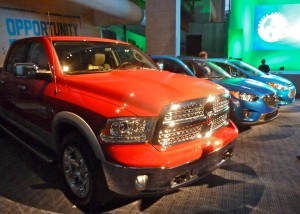
"Don't call me Dodge" Ram 1500 outpointed the Mazda CX-5 and Ford C-Max to win Truck/Utility of the Year.
Both award winners are comparatively traditional, with the Ram powered by either the Hemi V8 or a new Pentastar V6, while the compact Cadillac ATS has either a V6 with rear-drive, or a turbocharged 4. They were in stark contrast to the other two finalists in both car and truck competition, which featured high-tech high-mileage options — as did the array of flashy new vehicles displayed during the two press preview days at Cobo Hall. Vehicles from all over the world emphasized futuristic electric or electrically-boosted vehicles with high mileage potential.
Among the highlights were an all-new compact CLA from Mercedes, a downsized “4-door coupe” shape with a 211-horsepower turbocharged 4-cylinder and a stunning drag coefficient of 0.22, which the company claims is best in the industry. A revised 4-Motion system and a collision-prevention assist will be features. The CLA will be widely promoted at the Super Bowl — which, incidentally, will be played in New Orleans, at a facility now known as the “Mercedes-Benz Superdome.” Mercedes is also unveiling the revised E-Class mid-range sedan and a new S-Class luxury car. The E-Class will come in coupe, convertible and sedan, and also returns as a station wagon, as well as a high-performing AMG E-63. BMW introduced the 4-Series, which will become the name for all 3-Series coupes and convertibles, and its MINI division displayed a Cooper-Works sporty version of its 4-door Clubman. Read more


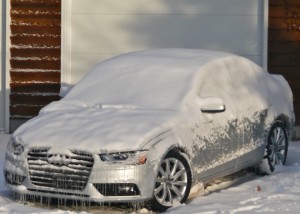
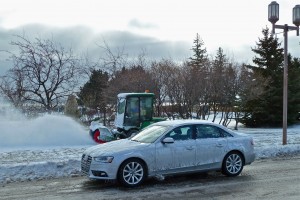
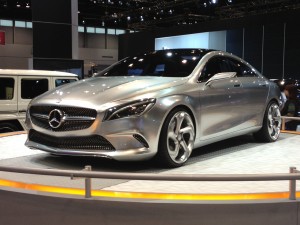
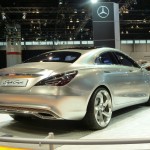
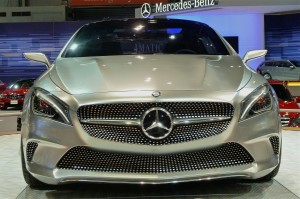

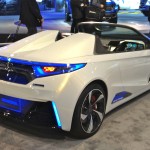
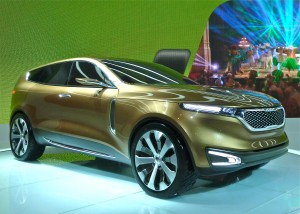
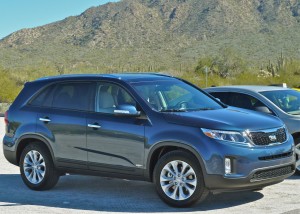
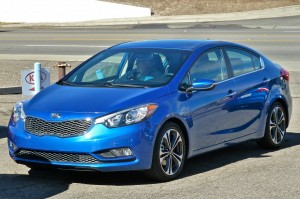
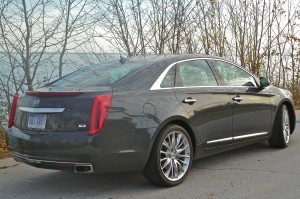
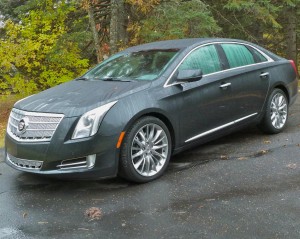
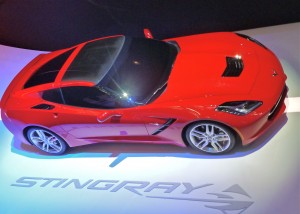
 John Gilbert is a lifetime Minnesotan and career journalist, specializing in cars and sports during and since spending 30 years at the Minneapolis Tribune, now the Star Tribune. More recently, he has continued translating the high-tech world of autos and sharing his passionate insights as a freelance writer/photographer/broadcaster. A member of the prestigious North American Car and Truck of the Year jury since 1993. John can be heard Monday-Friday from 9-11am on 610 KDAL(www.kdal610.com) on the "John Gilbert Show," and writes a column in the Duluth Reader.
John Gilbert is a lifetime Minnesotan and career journalist, specializing in cars and sports during and since spending 30 years at the Minneapolis Tribune, now the Star Tribune. More recently, he has continued translating the high-tech world of autos and sharing his passionate insights as a freelance writer/photographer/broadcaster. A member of the prestigious North American Car and Truck of the Year jury since 1993. John can be heard Monday-Friday from 9-11am on 610 KDAL(www.kdal610.com) on the "John Gilbert Show," and writes a column in the Duluth Reader.